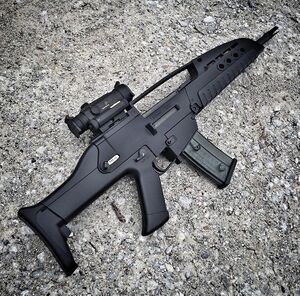ARO FC-7
| FC-7 | |
|---|---|
 | |
| Type | |
| Place of origin | |
| Service history | |
| In service | 2007 - present |
| Used by | |
| Production history | |
| Designed | 1995 - 1999 |
| Manufacturer | Arsenale Reale e Ordinanza S.p.A |
| Produced | 2005–present |
| Variants | See variants |
| Specifications | |
| Weight | 2.8 kg (6.2 lb) |
| Length | 840 mm (33 in) |
| Barrel length | 320 mm (12.5 in) |
| Cartridge | 6.45x48 mm |
| Action | Gas-operated, rotating bolt |
| Rate of fire | 750 rounds/min |
| Muzzle velocity | approx. 900 m/s (see variants) |
| Feed system | 30-round detachable box magazine |
| Sights | ISM-V Unmagnified reflex sight (4x for DMR variant) or rail equipped carry handle for various optics |
The ARO FC-7 is a selective-fire modular weapons system chambered for the 6.45x48 mm round and developed and produced by Arsenale Reale e Ordinanza S.p.A of Luminerra for the Lumenic Legion to replace the FC-72 assault rifle.
Presently, the ARO FC-7 is being phased out in favor of the ARO FC-18
History and development
Development of the FC-7 began as early as 1993 with the intention of replacing the FC-72 assault rifle. As the rifle was neatly complete and ready for field testing when the 1999 Forza Futura was accepted, the FC-7 was not included in that programs development goals. In essence, a program to replace the FC-7 had already been initiated before the rifle was even accepted into service.
The first 30 FC-7 carbine prototypes were delivered to the Lumenic Army in November of 2000 for preliminary testing. Later, at least 200 developmental prototypes were procured covering all four weapon system requirement; carbine, personal defense weapon, marksman rifle, and squad automatic weapon. Among the complaints during testing was that the battery life was too low for the weapon's powered sight system and some ergonomics issues. Two other key issues were reducing the weapon's weight and increasing the heat resistance of the hand guard, which would start to melt after firing too many rounds. The main testing was largely completed, and the Legion pushed for funding for a large field test. However, in 2002, the Senātus denied ₳26 million funding for 7,000 rifles to do a wide scale test fielding of the FC-7 in 2003, stating that the money would be released and field tests could be conducted when the chief complaints of the initial testing round had been addressed. The weight of the FC-7 carbine was reduced from 3.4 kg (7.5 lb) to 2.8 kg (6.2 lb). ARO noted that while it had failed to reach the program target weight of 2.6 kg (5.7 lb), the extra weight was due to reconstruction and redesign of the hand guard, increasing its heat resistance significantly. With these issues addressed, the funding for more rifles was released, and large scale troop trials slated for 2004.
In the 2000 test, FC-7 rifles recorded a total of 307 stoppages. In the Summer 2004 test, the FC-7 recorded only 127 stoppages in 60,000 total rounds. No further issues with heat resistance within the hand guard were observed.
Although initially part of the original testing, the FC-7FA preformed poorly, outperforming the ML-89, but not offering any advantage over the existing ML-95 squad automatic weapon. Additionally, the FC-7FA lacked several key features that the Lumenic Army found desirable regarding the ML-95, notably fast barrel replacement capability, a high rate of fire, and the option for a belt-feed system. With the ML-89 already being phased out by a superior weapon to both it and the FC-7FA, the FC-7FA was dropped from the development cycle in 2003, and would not be included in the planned large troop trials slated for 2004.
Concurrently to the development and testing of the rifle, ARO, along with Ordigno Esplosivo S.p.A, was engaged in development of companion grenade launcher for the FC-7. This device, unlike the initial FC-7, was met with general interest from the Legion, as it was both backward computable with the FC-72, and could be used as a stand alone weapon system. The Lanciatoregranate 07, or LG-07, received approval and funding from the Ministry of Defense in 2007
An electronic round counter was proposed for the FC-7. The system would have tracked the number of rounds fired and the date and time of each shot. The data would then be accessed wirelessly by a device like a PDA. Another benefit would be to monitor unauthorized weapon use or corroborate field reports. While this system was seen as beneficial by both ARO and the Lumenic Legion, it was ultimately dropped from the design in 2006.
Design
The materials used to build the FC-7 are almost entirely composites, with the notable exception of the cold-hammer-forged steel barrel. This has contributed greatly to the weapons lightweight construction. Many features that would be separate accessories on other weapons have been integrated into the design, thereby saving both cost and weight. These features include a reflex aiming device, laser aiming module, and a bipod
The FC-98 carbine barrel is 368 mm (14.5 in) and the FC-7 barrel is 317 mm (12.5 in) but the rifles have the same overall length. Although a shorter barrel generally results in lower muzzle velocity, polygonal rifling techniques partially compensates for the loss of velocity from a shorter barrel.
The FC-7 also departs from the traditional rail integration system found on the FC-98 rifles and other rifle designs from around the world. In its place is a proprietary system developed by ARO called the Punti di Attacco di Combattimento, or Combat Attachment Points, PAC for short. The benefit of the PAC system when compared to standard RIS attachments is the precision of the accessory's connection with the body of the weapon; accessories utilizing rails often need adjustment if they are removed and reattached. Additionally, most standard accessory functionality is built into the FC-7, as it contained an integrated reflex sight and laser illumination device. While the PAC system was not backwards compatible with existing RS mounted device, it was anticipated by ARO that accessories would be redesigned to utilize the new system. However, complaints regarding the battery life of the integrated optic, and regarding the lack of modularity and customization, spurred ARO to develop a version of the FC-7 with a traditional rail integration systems, primarily for use with special forces operators. The new carry handle does attach to the rifle via the PAC system. The grenade mounting point remains unchanged, and continues to utilize the PAC mounting system.
Initial versions of the FC-7 included an integrated electronic non-magnified weapon sight which also contained a visible/IR laser. The only expectation to this, initially, was a 3.5x magnified sight for the FC-7TD designated marksman rifle. The purpose of the integrated sight/laser was to eliminate the weight and cost of requiring multiple accessories to be attached to the rifle via attachment points. The baseline FC-7 carbine can be compared to an most other military carbines with a host of previous-generation electronic add-ons, including optical and iron sights along with a laser aiming device. These comparisons showed that the rifle was heavier than the FC-7, in addition to being more cost effective and logistically sound, requiring fewer parts. The optic attachment point can also take a block containing a standard set of rear iron sights, and the front of the rifle has an attachment point for a front post sight as well, allowing for non-optical sights to be used.
Variants
| Designation | Type | Weight | Barrell Length | Notes |
|---|---|---|---|---|
Civilian versions
In 2013, with the introduction of a PAC attached carry handle featuring an integrated rail system, ARO decided to contract production of several thousand FC-7's to <another manufacture> for sale on the Lumenic and international civilian firearms market. This version of the FC-7, designated the FS-19 is a semitauonic only rifle, and dispenses with the PAC attachment system in favor of more traditional rail integration attachment points on the top of the rifle, as well as along the bottom and sides of the handguard.
In 2015, the Lumenic Legion requested a small batch of automatic rifles retaining the FS-19 design be built by ARO for the Legion's special forces. These rifles are designated FC-7A1 in the Lumenic Legions inventory system.



